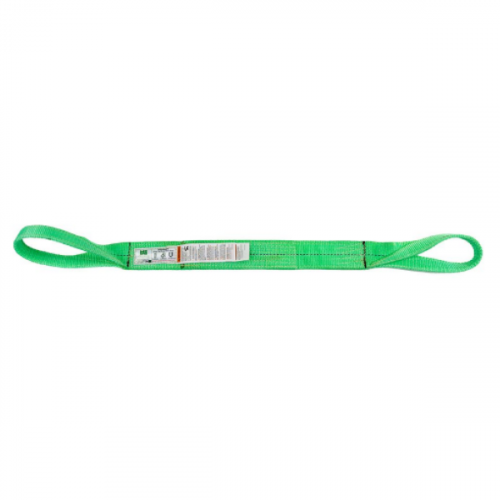Home / Rigging / Lifting Slings / ... / Webbing Slings
Webbing Slings
(8 products)
Webbing Slings
(8 products)
Page 1 of 1
Results per page
Filter (0)
Page 1 of 1
Results per page
What are Web Slings?
Webbing Slings frequently known as Web Slings are available in Nylon, Polyester and Dyneema offer a multitude of advantages over each other, and should be selected depending on the type of load, environment, load size, and weight.
Our manufacturers produce only the highest quality products to meet the strict demands of OSHA and ASME B30.9 giving you total compliance and complete peace of mind. Each item is marked with the following information for identification purposes: manufacturer's name/mark, stock code, rated load, type of material, and the number of legs (if applicable).
Simply the best, forget the rest Lifting Equipment Store have been supplying Nylon, Polyester, and Dyneema Web Slings throughout the world since 2011, you can be sure you’re in the very best hands when shopping with us, from simple one-piece orders to bulk requirements, we have rapid availability and the ability to produce enormous quantities of equipment in very short timescales. We’re extremely familiar with export and logistics which enables us to stay extremely competitive no matter where you’re located- downtown or out of town, we got you!
Type and Designs - Synthetic Webbing Slings come in a variety of different formats designed for different applications with the most common being the eye-eye and endless types that can be used in a combination of hitches to achieve varied load capacities and to accommodate different loads. Other types include reversed eye, wide-body cargo, hardware installed such as hooks and triangles as well as ‘bridle’ type slings which suspend multiple legs from a top master link.
Materials and Properties :
Nylon slings are common throughout the USA as a general-purpose synthetic sling that provides a degree of resistance to certain alkalis but are strictly not for use with acids and bleaching agents.
Polyester slings are industry-standard throughout many countries and are not noticeably affected by these compounds: water (this includes the sea, soaps, synthetic detergents and hydrocarbons.
Dyneema is the world's strongest fiber, offering extremely high cut resistance, low weight, and enormous working load limits. its ability to float on the water makes our Dyneema slings the ultimate offshore synthetic rigging.
Our standard range offers capacities from 1900lbs-106,000lbs and larger on request. Online we offer lengths up to 10m, but offline we can offer custom manufacture, right here in America with length to your exact specification along with any rigging attachments, fittings, etc.
Our manufacturers stand in Los Angeles and Houston offering a nationwide direct delivery service which ensures extremely fast delivery times on our standard range of webbing right when you need it, US-made custom orders may take a little longer but we aim to offer reasonably fast service on all bespoke jobs, we understand your urgency!
Things to Remember About Web Slings
Inspections
Frequent Inspections should be performed before each shift or day in normal service and more frequently when used aggressively.
Periodic inspections should be carried out by a competent qualified person or inspection body and documented evidence in the form of an inspection report must detail any defects. We’ve outlined the basic periodic inspection timeframes below (as recommended by ASME):
Normal service: Annually
Aggressive service: Monthly to quarterly
Unique service: to be advised by a professional
Damage
From time to time they get damaged, this can be through general wear and tear aggressive activity, or simply misuse. If showing any cuts or tears, snags, holes, weld spatter, melting, burns, broken and worn stitching, knots, excessive abrasion, crushing, red core showing, signs of stretching/overloading or UV degradation and similar signs should see the offending sling disposed of immediately.
ASME B30.9 Removal From Service Criteria
- Missing or illegible sling identification (this includes manufacturer name/mark, manufacturers stock code, rated load, type of synthetic material, number of legs if more than one
- Acid or caustic burns
- Melting or charring of any part
- Holes, cuts, tears or snags
- Broken or worn stitching in the load-bearing splices
- Excessive abrasive wear
- Knots in any part
- Discoloration and brittle or still areas on any part of the product, which may mean chemical or ultraviolet damage
- Fittings that are pitted, corroded, cracked, bent, twisted, gouged or broken
- For hooks, removal criteria as stated in ASME B30.10
- For other applicable hardware, removal criteria as stated in ASME B30.26
- Other conditions, including visible damage, that cause doubt as to the continued use of the item
Repairs
If economically appropriate in some instances can be repaired. Any repairs should also be carried out by a professional and competent person and then thoroughly inspected and tested to the relevant OSHA or ASME requirements at twice the working load limit along with any manufacturers' recommendations.
Should you have any questions or queries regarding our range, please feel free to contact a member of our sales team and we can take care of your requirements.













































